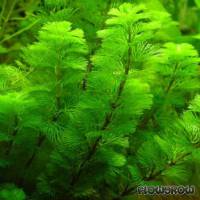



Cabomba caroliniana var. caroliniana aka green Cabomba is a very popular aquarium plant, originating from lakes, ponds and rivers in the Americas, usually with a low pH. It is often found in trade. In nature, this Cabomba is know to spread very fast, and in some countries like e.g. Australia it is considered an invasive species, or Weed of National Significance.
When cultivated in optimal conditions, the stalks of C. caroliniana var. caroliniana can easily grow to the surface of a large aquarium, even when trimmed drastically. There, it forms ovate to diamond-shaped floating leaves and white flowers. However, if temperatures in the tank are too high, or the light is too low, the plant grows weak and tends to etiolate. C. caroliniana var. caroliniana seems to need light, first and foremost, the pH and water hardness do not play too big a role. Micronutrients may be beneficial to its growth and make it more robust, though. By limiting nitrate supply the keeper can influence the hue of green, it is darker to even brown when nitrate is low, especially if the light is intensive. There is no need to supply additional CO2, however, it will boost growth even further if supplied.
C. caroliniana var. caroliniana can be propagated like any other stem plant, however, please keep in mind that the lower part of cut stems may need some time to grow lateral shoots, as those are rather uncommon in this plant.
In aquaria, this plant is a welcome contrast to other plants with different leaf forms and colours for the background, with its limegreen colour and its finely forked leaves.
<a href="https://www.flowgrow.de/db/aquaticplants/cabomba-caroliniana-var-caroliniana" target="_blank"><img alt="Cabomba caroliniana var. caroliniana" title="Cabomba caroliniana var. caroliniana" src="https://www.flowgrow.de/db/widget/aquaticplants/cabomba-caroliniana-var-caroliniana" /></a>
[url=https://www.flowgrow.de/db/aquaticplants/cabomba-caroliniana-var-caroliniana][img]https://www.flowgrow.de/db/widget/aquaticplants/cabomba-caroliniana-var-caroliniana[/img][/url]
[widget=aquaticplants/cabomba-caroliniana-var-caroliniana]Cabomba caroliniana var. caroliniana[/widget]